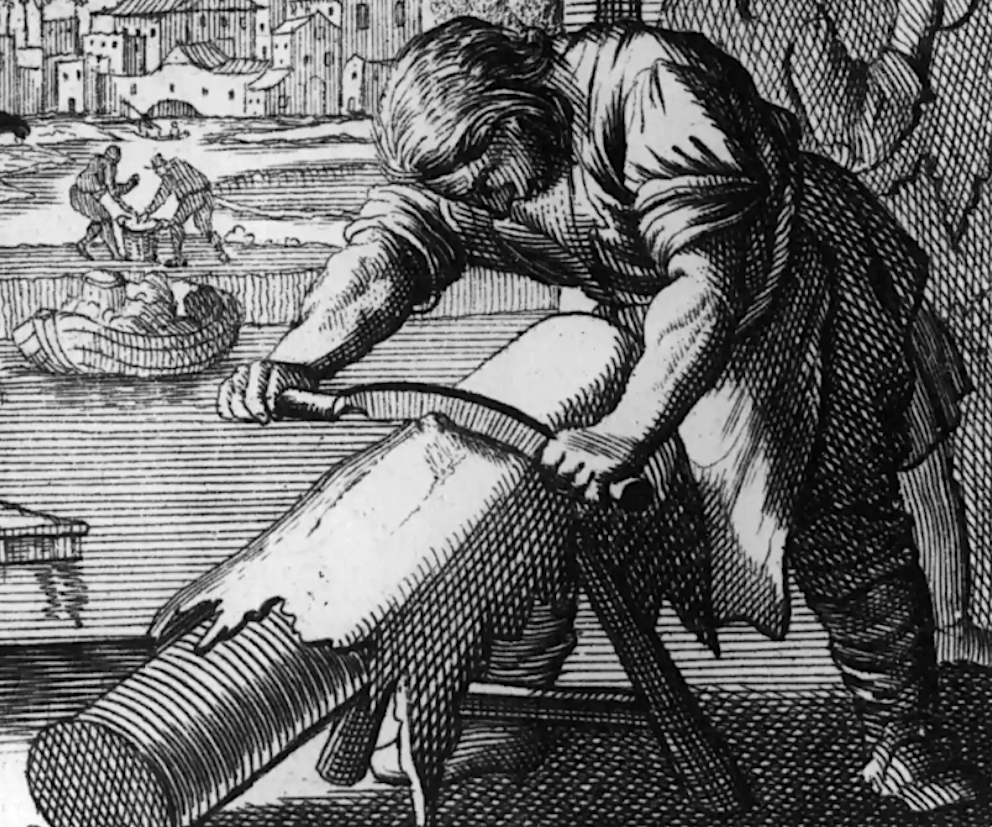Currier
Curriers were part of St Ives' leather trade. An ancient occupation, the earliest record in England is 1276. Fellmongers and tanners first treated the hides. Curriers transformed the hides into strong, flexible, stained and waterproof leather. A cordwainer finally worked the leather into a finished product. Read on to learn more about the trade and a St Ivian who was a currier.
Curriers worked on cow, pig and sheep hides, even goat, deer and rabbit. The job required hard manual effort and skill using a range of special hand tools.
Stretched on a frame and tightened, the currier washed and scrubbed the hide. A short-bladed knife called a sleeker forced out any tanning fluid. A further stretch followed. The currier trimmed the hide to a required thickness and size. He finally tanned the hide and massaged it with beef tallow and cod liver oil.
Currying tended to be a family trade, with sons undergoing a seven-year apprenticeship. The trade declined in the early part of the 20th century, with manual labour replaced by machines.
Here are details of two St Ives currier families.
John Warner
John was born in St Ives in 1811. His mother, Mary Ann, died two years later of consumption. John's father, of the same name, had six children to care for.
John followed in his father's profession as a currier. Married in the 1830s, for a period in the 1840s he traded as a butcher living in Sheepmarket. By 1851, John was back to currying. Business was good. He employed seven men. He also had two sons, two daughters, a housemaid and a cook. It's likely by this date he had moved to Stanley House, Market Hill.
By 1871, John described himself as a landowner. His son, William Wigston Warner, still living at home, was a currier employing eight curriers and three labourers as well as being a landowner. Brother Robert, aged 26 years, was doing equally well, a farmer with 370 acres employing ten men and four boys.
John died in 1872, aged 62 years. He left St Ives a strong legacy. Both his sons and one daughter continued to live in Stanley House, today occupied by St Ives Town Council. William was St Ives Mayor five times between 1877 and 1897, and served as a Justice of the Peace. On William's death in 1905, he gifted to St Ives in his will a close of land for a public park in St Ives, today a much loved green space in the centre of the town known as Warners Park.
Benjamin Curtis
This family of leather workers originated from North Walsham. The first record of Benjamin is in 1839, employed by Mr Hopkins, currier, of St Ives. Benjamin was returning home from Stourbridge Fair in Cambridge with a wagon-load of leather. Seated on top of his load, a mile from home he fell from the wagon. Both wheels passed over him. A compound fracture of one leg and a broken thigh on the other were the result. The surgeon thought amputation would not be necessary. Benjamin was doing well (Cambridge General Advertiser 2 Oct 1839).
In hospital, Benjamin's wife left him momentarily. He suffered a fit. Landing on the floor, he dislocated the recently set bones and suffered a haemorrhage. Benjamin died within an hour. (Cambridge General Advertiser 9 Oct 1839). Another newspaper reported he died "leaving a widow and six children destitute".
Sarah and the children lived in Cow and Hare Yard in 1841. She had her hands full. The youngest child aged 2 years was born in the year of Benjamin's death. Sarah worked as a laundress, taking in everyone's dirty linen. In 1844 she married William Wilkinson, a currier journeyman.
Son Benjamin died in 1843 aged 6 years. The other three sons worked in the St Ives leather trade. Both William and John were curriers, George a leather seller.
To read more about old St Ives occupations, click here.



No comments:
Post a Comment